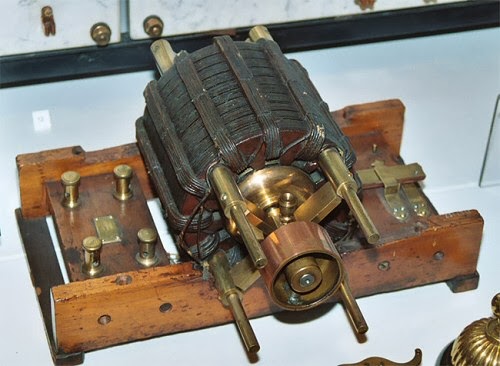Sunday, November 2, 2014
Monday, June 30, 2014
Thursday, June 26, 2014
Lafayette Radio
When I was a young teen, I couldn't wait to get my new Allied and Lafayette Radio catalogs. Living far from the city, my choices for electronic parts were mail order or the local TV repair shop. Allied is still around but Lafayette long ago gave up the ghost. Here is a great history article (LOTS of pictures) on the history of Lafayette Radio.
Friday, June 20, 2014
Monday, June 2, 2014
Sunday, May 25, 2014
Museum of Ye Olde Test Equipment
I just bought one of these on E-Bay to do subwoofer frequency sweeps for audible artifacts in rooms other than the lab. I found this picture on a virtual old test equipment museum site:
Saturday, May 24, 2014
Sunday, May 11, 2014
Monday, May 5, 2014
Klystrons
Eimac in 1960 designing and building Klystrons. I got to replace a few in a UHF TV station in the 1970s. Click on the picture for a larger view.
Friday, May 2, 2014
Ultimate Hamshack - W9EVT
Oh. My. God. I've died and gone to (ham) heaven! Click on the image to enlarge. There's more. Check out the antenna farm and other radio rooms on W9EVT's QRZ.com page.
Ugly vs Pristine
Pristine construction with nice right angle bends on silver plated wire are shown here in Lane Upton's Browning-Drake Receiver. More pictures can be found on that website.
This is NOT how to prototype. In fairness, the final version of this design looks much better. It is a vacuum tube AM stereo transmitter as seen here on the radiomuseum.org site.
This is NOT how to prototype. In fairness, the final version of this design looks much better. It is a vacuum tube AM stereo transmitter as seen here on the radiomuseum.org site.
Thursday, May 1, 2014
Friday, April 25, 2014
Bit by Bit
For a great history of computing, visit Bit by Bit. This site was put together to augment the Computer Science 147: History of Mechanized Thought class at Haverford College
Quote from their site: "The site provides an historical overview of mathematical and computational technology, spanning from the abacus to the Apple computers." The pictures alone make it worth the visit.
The Institute for Advanced Study computer (above) is on display at the Smithsonian Institution in Washington, D.C. The protruding cylinders at the base of the machine are CRT storage tubes, each capable of holding 1,024 bits. There were twenty tubes on each side of the machine.
Quote from their site: "The site provides an historical overview of mathematical and computational technology, spanning from the abacus to the Apple computers." The pictures alone make it worth the visit.
The Institute for Advanced Study computer (above) is on display at the Smithsonian Institution in Washington, D.C. The protruding cylinders at the base of the machine are CRT storage tubes, each capable of holding 1,024 bits. There were twenty tubes on each side of the machine.
Click the above image to see more detail.
Sunday, April 13, 2014
Electronic Hobbyist Essentials 1968
Simpson 260 VOM - out of my price range at the age of 13 but considered the standard by the telephone company, TV broadcasters and electricians everywhere.
RCA VoltOhmist VTVM - also a standard but I had a Conar model. Later I used a Heathkit model in 1980 at Carver Corp., before they switched to nice Fluke DMMs.
Weller standard issue 100/140W soldering gun - I used mine so much that the transformer inside it would bubble it's oil. I quickly discovered that I could make the tips from #12 house wiring. The tips were soft and burned out quicker but dirt cheap. In retrospect, this may be why the transformer bubbled so much.
Wednesday, March 26, 2014
Tuesday, March 25, 2014
ART-13
Collins Radio ART-13 Navy Transmitter 1942
I junked one of these out once for parts. They had an intricate preset system to auto set all the lower knobs by mechanical means. Pretty cool design!
Click for larger view.
Thursday, March 6, 2014
Vintage Test Equipment Website
Check out myvintagetv.com for a great photo gallery of old test equipment!
Vintage Ad Website
What a find! At VintageAdBrowser.com, they have thousands of ads on all merchandise dating back to 1900. I could spend days in there....
Wednesday, March 5, 2014
Prototypes in Real Life
After many trips to Radio Shack for more alligator clips.... This image is an audio synthesizer project from MultiPhase Diary. Click image for a larger view.
Sunday, March 2, 2014
Cool Workbench
Click to enlarge. This is how a REAL project workbench looks! From la1tpa-qrp.blog
I love all the homemade test equipment.
ICOM R-75 General Coverage Receiver
My current shortwave receiver - the Icom R-75. She is a pretty good performer but I have too much RFI from all the network devices in my house and can't hear much.
Sunday, February 23, 2014
Saturday, February 22, 2014
My Dad's First CB Radios
Dad had two of these, one in a 1954 Jeep pickup and one in our house. They retailed for $99 each in 1965 and were an all vacuum tube design. Hanging one of these 12" x 10" x 5" boxes from the ceiling of the jeep was probably not a safe idea. KLD 2785 was his callsign.
1954 Willys Jeep pickup - the first car I drove - NOTHING like the driver's ed car....Dad thought these $9 each walkie talkies would help with communication on the ranch. Sadly, they had a range of less than a quarter mile (about maximum yelling distance) with their super regenerative receivers and ate 9V batteries like no tomorrow.
Friday, February 14, 2014
Wednesday, February 12, 2014
Sunday, January 12, 2014
Subscribe to:
Posts (Atom)













































